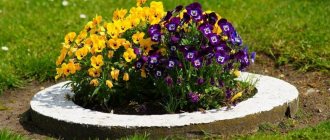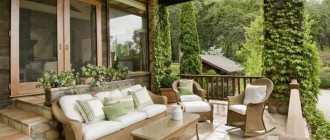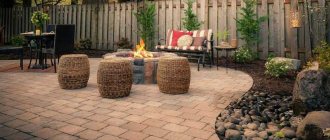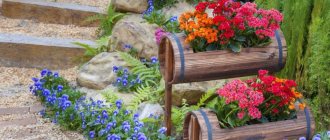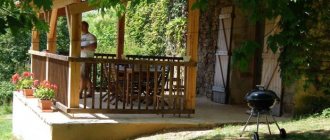For people who are far from agriculture and do not have dachas, a well on a property is associated only with an ancient structure in an abandoned village. However, modern wells on a personal plot have a very presentable appearance. They are installed in different ways, and the purpose of these buildings is not limited to just receiving water.
Birch well
Well made of timber
The drainage well on the site is part of the drainage structure. Such communications are used in dachas with high groundwater levels or on soils that retain liquid (loam). Drainage lines help remove excess water from the ground and prevent the root systems of plants from rotting. Plastic wells for dachas are mounted on the upper sections of the system and are used to monitor the full operation of communications.
Well made of rubble stone
Well with flowers
The main purpose of a decorative well is to decorate the site. In order for the design to attract attention with an elegant and unusual appearance, you should not install ready-made store models on the sites. Quite a lot of ideas for building a non-standard house for a well can be found on the Internet or in magazines.
A shaft well is designed to collect water from underground sources. Before building a well in the country in the form of a vertical shaft, they decide on the installation method: open or closed.
Before you make a well at your dacha with your own hands, preparatory work is carried out, which takes into account two factors: where to place the well and the time suitable for installation work.
When choosing a place to dig a well on a site, it is usually recommended to use several search methods, but no old-fashioned methods guarantee a reliable result. The most reliable option for finding a place for a well is geological exploration, but its high cost is a significant disadvantage. Asking neighbors who have wells on their property is the most reliable and proven way to choose a location for a well on their property. At the same time, you can inquire about the depth of the mines and the quality of the water.
Well at the dacha
Decorative well at the dacha
Before choosing a location for a well, it should be taken into account that it must be close to the water consumption area, but no closer than 5 meters to the house, and also at a considerable distance from garbage, manure heaps or compost pits. On sloping areas, the well is placed above sources of pollution.
It is best to install a well on a summer cottage at the end of winter or at the end of summer. In winter, of course, it is more difficult to carry out work, but it happens that this is the only suitable time.
There are several technologies for building a well on a summer cottage.
Well with decor at the dacha
Wooden well
Construction of a well at the dacha using an open method
This technology is recommended for use in areas with dense soil.
The shaft for installing concrete rings is dug to the required depth (to the aquifer) immediately, from start to finish. Moreover, its diameter should be 10-15 cm larger than that of the reinforced concrete rings that form the walls of the well. The rings are lowered one by one into the dug shaft using a winch. To ensure reliability of the design, the parts are carefully fastened together. The rings must be secured with brackets to minimize possible horizontal and vertical shifts of the elements. This is a mandatory requirement if the well at the dacha is installed on sandy lands.
Wooden well
Well house
After installing the structure, the seams must be sealed. The joints in the upper two-thirds of the structure are sealed with sealants (cement mortar, liquid glass or hydraulic seals). The functional purpose of the sealant is to protect the well from groundwater.
The gap between the walls of the shaft and the structure is filled with coarse sand.
Advantages of this method: it is more comfortable to dig; when you encounter a boulder, you can dig around the stone, secure it with ropes and pull it to the surface.
Well with exotic plants
Stone well
Disadvantages: special equipment is required (cable, block, tripod, winch). When digging the earth, the diameter of the hole is larger than the ring parameter. After installing the structure, the gap between the walls of the earth and the rings is filled with other soil, which can subsequently move. This can lead to displacement of the rings and destruction of the well. Since there is a high probability of the walls of the shaft crumbling, it is recommended to install all the rings within 3 days.
Stone well at the dacha
Well depth and well improvement
How deep should you build a well?
This criterion directly depends on natural factors. For calculations, it is necessary to carry out test drilling. This will allow you to determine the exact volume of liquid and time to fill the recess. Experts say that in order to create a high-quality structure, it is necessary to make 3 shafts. This will allow for constant fluid supplies throughout the entire time.
Removal of the earthen substrate continues until traces of moisture appear at the bottom.
The side walls of the shaft are strengthened with concrete rings. This will prevent the soil from collapsing during the operation of the well. Some people prefer to use wooden rings.
How to arrange a plot in the Russian style: the best ideas for creating a beautiful and cozy plot (145 photos and videos)Do-it-yourself pond on a summer cottage: detailed description of the construction of a decorative pond, design and design options (110 photos and videos)
Stone retaining walls are options for constructing and arranging areas with a slope. 115 photos of landscape design ideas
After this, the bottom filter is poured. It is made from a mixture of river sand, small and large pebbles. During the filling process, the water will pass through forced filtration, thereby getting rid of ground debris.
Construction of a well on a summer cottage using a closed method
Experts call this method “in the ring.” It is advisable to use it on loose soils (crushed stone, sand), since the walls of the shaft will shift and crumble during operation. How to dig a well yourself? The sequence of work is simple.
The top layer of earth is removed according to the diameter of the reinforced concrete ring. Next, you need to dig a hole to a depth of 15 cm to 2 meters (as far as the soil allows). The ring is carefully placed into the formed recess. Subsequent lowerings into the ground are made inside the rings (which will begin to lower under the influence of their own weight). When the aquifer is reached, the last concrete element is installed, which is not completely buried. The boundaries of adjacent rings are treated in the same way as in the open method - insulation and sealing.
Brick well at the dacha
Advantages: there is no possibility of soil collapse - the rings are lowered into the ground under the influence of their own weight and the integrity of the soil walls is maintained.
Disadvantages: it is more difficult to work inside the space of a reinforced concrete pipe. If you come across a stone of considerable size, then there is a high probability that it will be difficult to remove and this problem cannot be resolved.
Flowerbed from a well on the site
Ideas for finishing decorative wells: photo gallery
Look at a selection of pictures and photos with options for arranging beautiful decorative wells and ways to use original structures in landscape design - from rustic, small imitation models to solid buildings made of stone, wood, and other materials:
Finishing style is an important detail when arranging a well
The final stage for any method of mounting the structure is the design of the wells. This is the most creative and creative process. To harmoniously combine the structure with the space of the site, it is recommended to select decor that matches the exterior of the house.
How to decorate a well in a dacha is up to each owner to decide for himself, but we should not forget that one of the purposes of a well house is to protect water supplies from precipitation and insects, and from debris blown by the wind.
Wrought iron well in the garden
Well with roof
Decorating a well at your dacha with your own hands can be done in any style. To do this, just use the appropriate materials and include your sense of style and imagination:
- Rural motifs are perfectly emphasized by stone/wood decor. The above-ground part of the structure (head) is made of solid logs in the form of a canopy (house). An excellent imitation of a log house - a quadrangular or hexagonal house for a well. Moreover, it is better to make only the lower part, the racks, wooden. And the roof itself should be made of a material of the same type as the roofing of the house. A cobblestone area around the head will complete the beautification of the place and make it easier to collect water. To make it easier to pour water into buckets, you can install a low bench. If the surrounding area is additionally landscaped with “country” flowers (petunias, marigolds), you will get a cozy and well-equipped relaxation area;
- finishing wells in a country house with a Japanese character involves the use of natural wood and large stones. The oriental character of the structure will be given by the special shape of the roof - hipped with raised corners at the edges. Soft tiles will help to decorate the roof in this way. Beautiful evergreens (mountain pine, juniper, thuja) will support the Japanese mood;
- how to equip a well in a country house built in a modern style? It’s easy and simple; it’s enough to add modernity to individual design elements. The concrete ring of the head can be decorated with tiles, and a polycarbonate roof can be attached. Forged gate and roof posts will look unusual.
Sometimes there are dachas in which the house is designed and decorated in the Russian style, and the landscape design of the site adheres to the Japanese direction. How to choose the right decor? In such cases, you should start from the location of the well: if it is close to the house, choose a house for the well that organically complements the main building. If the well is “lost” on the site, create a well design on the site that fits the structure into the landscape.
Larch well
Construction instructions
To build a wooden well you will need the following tools and accessories:
- hacksaw for cutting boards;
- edged boards and timber;
- jigsaw;
- hammer and nails (you can use self-tapping screws).
Decide whether your well will be mobile or stationary. For the first option, you will need plywood sheets or drywall to construct the bottom, and for the second, pipes with cement mortar to build the base.
On a note! If you want to turn your plot into something like an estate that was owned by aristocrats, complement your landscape decor with a well decorated with carvings. Such a structure always looks luxurious and cute.
Before starting construction, we advise you to make a sketch of the future well, reflecting your wishes regarding the design features and design. The configuration of the base and roof can be varied: square, rounded, trapezoidal. This parameter affects the construction of the foundation and frame base of the well.
A wonderful solution would be to build a decorative well next to an artificial pond, if there is one on the site.
The assembly of a permanently installed wooden well is carried out according to the following scheme.
- The timber supports are buried in the soil by driving in pieces of pipe of the required size.
To do this, make holes in the soil 25-30 centimeters deep. The number of supports depends on the configuration of the well. If the structure is square, install four supports for the base and two extended ones to support the roof. Treating wooden parts with protective compounds will help protect the well from destruction. Pipes should be painted to prevent rust. - Pour a bitumen composition that has a liquid consistency into the holes and wait until the soil absorbs it. After this, the pits are filled ½ full with a solution prepared on the basis of cement, then sections of pipes designed to hold the construction of the well structure are installed. The holes are filled completely; if they are too wide, they are filled with expanded clay or crushed stone, and then filled with mortar.
- You need to check the placement of the pipes using a level: it is important that they are positioned evenly. The solution takes several days to harden, after which wooden posts are inserted into the pipes.
- To cover a wooden frame, boards are used: they are laid in a horizontal or vertical position. In the first case, there is no need to install additional frame elements, with the exception of racks. In the second, you will need to secure two horizontal bars on each side to secure the sheathing.
- The roof frame is assembled autonomously, and only after that the roof is attached to the base.
The roof can have a different design: be solid, cone-shaped, pitched, or have holes. Experts advise designing a gable roof. Overhangs of different lengths will help add originality to the design. To design a gable roof, you will need triangular-shaped gables made of plywood sheets, slats or boards. After this, the frame is covered with a suitable material (remember that the material must be weather-resistant).
Advice! Equip a small flower bed in a decorative well. A well with flowers will make your landscape design bright and original.
With the right approach, building a decorative well will not take much time. Step-by-step instructions will allow you to quickly arrange a beautiful and original well structure on your site.
At the final stage, the well is supplemented with traditional paraphernalia: a bucket on a chain, a log gate, a handle. The listed parts do not have a functional load and are not used for their intended purpose: they perform an exclusively decorative function - they decorate the well.
Read about how and what type of shed you can build for your summer cottage: wooden, metal, corrugated sheets - design and design options with examples in the photo.
You can see photos of forged benches and benches for decorating a summer cottage or garden area here.
Read the details of installing a picket fence at:
In order for the well structure to look attractive and fit organically into the country decor, you need to take care of its decoration and decorate it. In a well, for example, you can make a flower bed, planting vine plants or flowers creeping along the ground in it, and attach a wheel to the side so that the structure looks like an old-fashioned one. Thanks to this decoration, the well will become an organic component of a presentable landscape design.
Well as an element of landscape design
Not all dachas or houses need an additional/spare source of water supply, but many lovers of country holidays would like to have a decorative well on their site as an integral attribute of a rural, leisurely and cozy way of life.
Well with lighting
Carved well at the dacha
Before installing such a structure, it is advisable to determine a suitable location for it. And it is advisable to immediately choose the style of the elements and details of the structure.
A decorative well does not provide for the presence of a natural source of water inside, but you should not limit yourself to a purely decorative function. Under the well house you can hide some communications/hatches, a container for collecting rainwater.
A great idea is to equip the decorative structure with night lighting, which can be part of the site’s lighting system. Or, as an option, make a decorative well an independent, interesting object illuminated at night.
Painted well
Well in Russian style
In order for a well in a garden plot to have a harmonious appearance, it must support the stylistic features of the dacha. In this case, a win-win option is to design a well at the dacha from building materials left over after the construction of the main house or some buildings.
In principle, there are absolutely no restrictions in the use of decor. Both old tires and noble stonework in a medieval style look creative.
A luxurious idea is to use a well to create a flower bed. Compact structures will be decorated with low flowers, and climbing plants will perfectly complement solid decorative wells.
Garden well
Well in the garden
Functions of a well structure
The construction and design of decorative wells on a summer cottage does not imply the creation of a water source for the owners, although previously such objects served primarily a practical purpose.
Today, decorative wells play a mainly aesthetic role and are an integral element of landscape decor. But among summer residents there are many who believe that a well should be used not only for decorative, but also for practical purposes.
Such an object can be endowed with useful functions:
- the upper part of the well can disguise communications;
- ensure protection of barrels filled with rainwater from contamination;
- Thanks to this element, you can hide the source of drinking water from view.
Wells decorated with carvings look very impressive. Objects in antique style are very popular, they can advantageously transform the most unremarkable area. With the right approach, a well can easily be turned into a stylish component of landscape design.
The main purpose of a decorative well is to perform an aesthetic function. How to improve a well in a country house? With proper design of such a structure and the elements surrounding it (a small artificial pond, a cart, a rock garden, flowerpots, a low wooden fence or fence, garden paths), you can create an exclusive design. Your garden will be the subject of admiration for everyone who comes to visit your dacha.
Mini-wells look very impressive, decorated with colorful flowers. Decorative plants are the easiest way to decorate such an object.
Details on how you can use phytomodules for vertical gardening in landscape design and residential interior design: photos with examples, features of creating living structures from green plants.
Read about what gabions are and how they are made in this article.
How to determine which is better: a well or a borehole
Having your own source of water on your property is a natural desire of any summer resident. Modern technological methods offer two options for fulfilling your dream: a well or a borehole. Only by weighing the pros and cons can you get a rough idea of these designs and decide what to choose.
Decorative well made of tires
A well is dug to obtain water from the upper layers of the soil (overwater). Advantages: simple installation of a well in the country, easy maintenance, affordable cost. Disadvantages: labor costs, dependence of the water level on the season, foreign objects getting into the water, the need to build additional structures that must be integrated into the landscape of the site (house for a well).
Decorative well made of branches
The well is drilled to the level of the aquifer. The first water carrier is up to 30 m, and the second - up to 60 m. Advantages of the well: more purified water, no foreign bodies, debris (midges), compact design, preservation of the landscape, does not dry out and provides high water yield, quick installation (drilling in 2- 3 days). Disadvantages: high cost.
Japanese style well
The choice of a natural water source model for a garden plot is influenced by many factors: the level of groundwater, the composition of the mail, the financial capabilities of the owners, the need for water, and so on. If it is difficult to decide (a well in the country or a borehole), then it is advisable to seek the help of specialists. Professionals will competently take into account the wishes of summer residents, the capabilities of the site and tell you how to build a well at the dacha or where to place the well.
LiveInternetLiveInternet
Monday, February 11, 2008 14:56 + in quotation book A city dweller of our time can hardly imagine the importance of a clean well for a village community in former times.
Alexey Savrasov Landscape with a well, 1868. Belief in the healing power of water flowing from the earth is rooted in ancient and even prehistoric cults. Within the framework of the worldview, a well is often a shaft for entering the underworld (the tale of Mrs. Snowstorm) or into the “waters of the depths,” where mysterious forces hide. Nostradamus's well is a symbol of infinity, mystery, healing, and predictions. The well is a symbol of depth and clarity. Christianity readily embraced the tradition of belief in the healing power of wells, and places of pilgrimage arose around sources of water associated with legends of miracles. They were associated with the Virgin Mary and often primarily with the healing of eye diseases (in the sense of the kinship of ideas: a water mirror and the eyes as a mirror of the soul). At the secular level, legends spoke of a “well of rejuvenation” (fountain of youth), which supposedly helped old people look younger (Indian tribes in the southeast of what is now the United States still have such “legendary” wells - Bimini). In Islam, a well, laid out in the form of a square with stone (brick), is a symbol of heaven. Among the Yucatan Mayans, well shafts in karst rock were sacred places to which sacrifices were made. The physician Chen Shigong, who lived during the Ming Dynasty (1368-1644), wrote in his book “The True Teaching of External Disciplines”: “Every husband who walks the same path from the village well should not have disrespect and neglect, arrogance and arrogance; modesty and deference, respect and consideration are extremely important.” Here the village well acts as a symbol of the homeland, native village, and unity of people. In China, the central essence of a manor or palace is the “heavenly well”, a symbol of the Heavenly Emptiness (palace complexes of China, Feng Shui symbols). Ancient Chinese literature also establishes a connection between the “well” and eroticism and the “celebratory love couple festival” on the seventh day of the seventh lunar month. The Slavic goddess Mokosh is associated with water and wells. Paraskeva Pyatnitsa was depicted on the wells, symbolizing successful trade, and meeting a girl going to the well was considered a good omen. In Russian folklore, people used to tell fortunes using winter water from wells. This happened on winter Anna, at the time of the winter solstice. For fortune-telling, they made a well out of sticks, locked it with a padlock and put the key under the pillow, saying: “Betrothed, mummer, come to water the horse, ask me for the key.” In Rus', wells were always covered with lids so as not to see the brownie. If the body of a deceased person was found in a well, several buckets had to be scooped out of the well, and only after that the water from it could be used. In fairy tales and dreams, according to depth psychology, wells often appear as places of penetration into unknown worlds of the unconscious, hidden and inaccessible to everyday life, in connection with symbolic ideas about a cleansing bath, drinking from the sources of life and quenching the thirst for higher knowledge.
Martiros Saryan At the well. Hot day. 1908 So I collected a collection of paintings to confirm or refute these thoughts. And let's start with paintings by Russian artists.
Konstantin Trutovsky Scene at the well
Alexey Strelkovsky At the well 1878
Vasily Golike Fortune telling. At the well. 1839
Ivan Vladimirov At the well 1905
A. and S. Tkachevs At the well Alexey Zhibinov At the well 1920s
Anatoly Kulinich At the well 1995
Annunciation (At the well) Mstera 19th century V. Babadin Scene at the well
V. Vasin At the well 1960 V. Lyashenko At the well
Valentin Tereshchenko At the well 2007
Vasily Efimov Indian women at the well 1952 Vladimir Markin At the well Grigory Gribov At the well 2005
Dmitry Nechitailo At the well near Pereslavl 1970
E. Bitkin At the well 2003
Konstantin Vasiliev At the well
Well 1877
M. Anikeev Meeting at the well 1960
M. Kolomiets At the well Maxim Shamota Rachel at the well 1991
Nikolai Sadyukov At the well 1973
Nikolay Pimonenko At the well
Taras Bocharov Ekaterina Komrakova At the well. Istobensk 1999
Yuri Chumakov Most Holy Sergei of Radonezh at the well 2000 Khariton Platonov Girl at the well
At the well
At the well
Matvey Chizhov At the Well (First Love) 1873 Materials used from the site: https://www.shutovart.ru/ru/projects/Magic%20Well/index.htm Pictures found on the Internet. TO BE CONTINUED
Series of messages “The Well”:
Part 1 – WELL IN PAINTING (PART 1 – RUSSIAN PAINTING) Part 2 – WELL IN PAINTING (PART 2 – WESTERN EUROPEAN PAINTING) Part 3 – WELL IN PAINTING (PART 3 – BIBLE STORIES ABOUT REBECCA E AND THE SAMARITAN WOMAN) ... Part 15 - WELL IN PAINTING (PART 15 - WELLS. CONTINUATION OF THE TOPIC) Part 16 - WELL IN PAINTING (PART 16 - MEETINGS AT A WELL. GENRE PAINTING.) Part 17 - WELL IN PAINTING (PART 17 - WELLS OF THE BES SPACE EXTREME)
| Categories: | Thematic selections of paintings |
Tags:
painting well
Cited 2 times Liked by: 4 users
Like share
0
Like
- 4
I liked the post - Quoted
- 0
Saved
- Add to quote book
- 0
Save to links
Liked4
0

